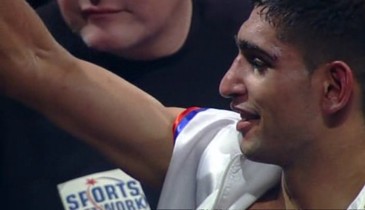 By Mel Dixon – “If I choose to fight again and he’s still up there [as world champion] – which I certainly hope he is, – then it’s a possibility.” – Ricky Hatton
By Mel Dixon – “If I choose to fight again and he’s still up there [as world champion] – which I certainly hope he is, – then it’s a possibility.” – Ricky Hatton
The news this week that Ricky Hatton would consider a fight with Amir Khan is further validation of the Bolton fighter’s status as ‘restored goods’ almost a year after his destruction at the hands of Breidis Prescott. It also signifies the contrasting fortunes of Ricky Hatton after his failed, though brave, quest to seek and destroy the world pound-for-pound kings. Nonetheless, Khan’s recovery under the guidance of Freddie Roach has been astonishingly swift to the extent that even his supporters couldn’t have foreseen the speed of his recovery.. So how has Amir Khan done it?
Some people would immediately answer this question by re-wording it: it’s not about how Amir Khan has done it; it’s about how Freddie Roach has masterminded it. This brings to mind the notion that Roach is somehow dictating his fighter’s every move via remote control from the corner. His influence is great, but it can be overstated, and this, in turn, unfairly overshadows the individual achievements of Khan himself; it’s a branch of reasoning often expounded by those who seek to explain Khan’s success without crediting the man himself.
After the Prescott debacle (in which he was counted out after just 55 seconds), there was a certain amount of glee expressed by parts of the British press and the general public. He’d been built up and now he’d been beaten down. Khan almost immediately relocated to America and put himself under the tutelage of Freddie Roach. It was a brave, albeit necessary, move. Roach threw him straight into sparring and was impressed by his speed and overall talent. But, if Khan hadn’t met his expectations, it’s most likely he would have been shown the door.
Khan was back in action against Oisin Fagin, at the end of 2008 – he was the ideal opponent given that he was a relatively light puncher. To Fagin’s credit he made a go of targeting Khan’s vulnerable temples, throwing roundhouse hooks with both hands, but Khan was ready and instinctively put ‘the earmuffs on.’ Roach had clearly got his charge ready to defend against such an attack – as if he, himself, recognised it as a weakness which others would try to exploit. The fight was stopped in the second round, after Fagin was knocked down for a second time (he reportedly broke his ankle during the first knockdown); and Khan’s confidence had been given a much needed boost.
Still, no-one foresaw his confidence to be so high as to take on Mexican legend Marco Antonio Barrera in his next contest. But that’s just what he did. In what turned out to be a perfect piece of match-making, Khan was in against a Barrera still considered dangerous by many experts, even if past his best. Personally, when I saw Barrera during the weigh-in, I felt he resembled the puffed up old fighter that he turned out to be. It was no surprise to me when Khan immediately dominated with his superior speed and size. Barrera was quickly hampered by a nasty cut on his head, and the fight should have immediately been called a no-contest, but it was allowed to continue until it was waived off in round 5. Regardless of the injury, Khan looked too fast and too sharp for the old warrior – a fact which made the naysayers sit up and take note…
The victory over Barrera gave Khan legitimacy as a challenger for Andreas Kotelnik’s WBA light-welterweight crown. This was the contest that would truly prove how much Khan had progressed since the Prescott debacle. When the bell signalled the end of the contest after twelve rounds, it was clear he had come a long way. His attacks were disciplined, his defence was solid, and his speed was, as ever, difficult to comprehend. What was particularly impressive was the way he responded whenever he got hit – every time he would immediately respond with his own punches. This clearly shocked Kotelnik who was unable to get any momentum during the fight.
It was an impressive points victory, which leaves Khan as a world champion with a range of options in front of him. He now stands as a restored fighter who’s looking better than ever, but as with any restoration, a closer inspection can reveal a few fine cracks. Freddie Roach has suggested that his punch resistance has improved now that he has moved up a division, but the way Roach has drilled him to protect those temples and keep on the move (both in an exaggerated manner), suggests that this will remain a weakness. The question is: who’s good enough to take advantage? Whoever that person might be, they won’t be fighting Khan next. Expect it to be a top-tier but beatable fighter. Someone who’s on the downward curve.
An Erik Morales or Junior Witter perhaps…